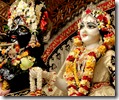 “God
does not interfere with the little independence of the living entity.
In Bhagavad-gita, the Lord has explained in all respects how one can
elevate his living condition.” (Shrila Prabhupada, Bhagavad-gita, 18.63
Purport)
“God
does not interfere with the little independence of the living entity.
In Bhagavad-gita, the Lord has explained in all respects how one can
elevate his living condition.” (Shrila Prabhupada, Bhagavad-gita, 18.63
Purport)
“I
hate it when people are mean to me. Why can’t everyone be nice? I try
to be nice to others. I bear no malice towards anyone. I don’t hold
grudges. In fact, after a few days, I forget about most things. Whether
something good happened or something bad, I move on fairly quickly. Why
can’t others do the same? Also, why does everyone have to drive so
poorly? They don’t signal when changing lanes, don’t slow down when
they’re behind me, and don’t maintain their speed when they see flashing
lights on the other side of the road. It would also be nice if others
didn’t chew with their mouths open. I hate that! That sound makes me
cringe. It would be nice if everyone behaved the way I wanted them to.”
Naturally,
the reaction to frustration is the desire to get others to behave the
way that you wish. Why would you want to live in danger or discomfort?
We get angry at our children precisely to get them to alter their
behavior. The same naughtiness in other young children puts a smile on
our face, but when we see our child we think, “Why can’t you do things
right?” We also worry that they won’t learn proper values if they
continue along this path.
But
what if you could control everyone’s behavior? Not just the odd person
who wronged you or the child who is under your care, what if you could
dictate how every single person in this world acts? This means that
people would be nice to you, they would give you what you want, whenever
you want, and you’d never be frustrated in your efforts.
While
it may be nice to ponder this idea, the reality is that the world full
of robots would be terribly frightening. You wouldn’t have anyone real
to go to. If you have a problem with something personal, if you wanted
to share your experiences from the day, or if you just wanted someone to
be by your side, the robot, the person trained to act only according to
your wishes voiced at a specific time, isn’t going to provide the
proper companionship. If such a thing were possible then you’d be happy
just going up to a tree and talking to it.
The
human being’s association is enjoyable precisely because there is some
independence. Actually, that independence is tied to life. That which
has the ability to act freely to some degree or another, sometimes
relying on intelligence at the local level, is a life force. The lower
species are considered inferior because their freedom is severely
limited. The same life force is there, but the ability to act is
hindered either by the lack of bodily features or the stunted growth in
intelligence. The hog will jump around in stool and the tree can’t move
or communicate.
The human
being also has independence, and the real potential within an existence
can be exhibited by them. We enjoy the company of our children because
they don’t have the same inhibitions that we have. They aren’t as shy,
and they haven’t lost their innocence. We don’t behave like them because
we care what others think about us a lot more. The child likes to have
fun in a free spirit, and it is nice for the adults to see this.
The
paramour is also an independent person who voluntarily chooses to be
with us. They have made the choice that we are important to them. We
have made the same choice regarding their association. Since they are
the same as us constitutionally, they feel the same happiness knowing
that someone else loves them. If either party were forced into the
relationship, brought in against their will, the feelings wouldn’t be
the same.
This review helps
to explain the relationship we have with God and why He would ever allow
us to separate from Him. According to the Vedas, all life forms are
originally with God. They are spirit souls at the core, and the origin
of spirit is God, who is also known as the Supreme Spirit. One of the
properties of spirit is independence, though in the expansions that are
the individual spirit souls the ability to act on independence is
limited. In simpler terms, the Supreme Lord, who is the most
independent, makes concessions to allow for the individual spiritual
fragments to act on their independence, depending on which choice they
make.
This brings us to residence in the material world, the
place where we witness such horrible things as death, old age and
disease. These come at unexpected times too and sometimes for the people
who seem to least deserve it. This is all bewildering to someone who
doesn’t see with the spiritual vision. If one thinks that life begins at
birth and ends at death, they will be greatly troubled by what they see
in this world. Through the eyes of shastra, or scripture, however, one
can see that life has its origin in life and that the origin of all life
is God.
As soon as any fragment of spirit desires to separate
from God, they are allowed to do so. They fall to the material world,
where the Lord’s presence is hidden. This is on purpose, as the initial
desire was to separate. As soon as the desire changes, as soon as it
flips back in the other direction, the same Creator manipulates events
in such a way that the masked presence suddenly becomes clearer. He
keeps the secrets about Him and how to return to His land safely within
the Vedas and other authentic spiritual traditions emanating from them.
Those who know these secrets and act upon them are thus the ones who can
reveal them to us.
The common complaint lodged against the
Lord, who in His original form is known as Krishna because He is
all-attractive, is that it was wrong for Him to allow anyone to descend
to the temporary and miserable material world. “If He really loved us,
He wouldn’t let us go somewhere that isn’t good for us.” But if you
think about it, His consent makes sense. If we would hate living in a
world full of robots who do whatever we want, all the time, why wouldn’t
God dislike the same thing? And on the flip side, if we feel pleasure
when someone voluntarily accepts our companionship, why wouldn’t Krishna
feel the same way?

Indeed,
the most exalted servants are those who voluntarily interact with
Krishna in a mood of love. In the spiritual world’s topmost planet there
is every variety we see in our present land, except the influence of
the nature is different. The effects of time are nonexistent, and so one
can stay there forever if they like. Clever people like Vrinda Devi and
Paurnamasi scheme every day on how they can arrange events so that
Krishna and His friends will have the most fun. And thus sometimes
through unexpected interactions, where it looks like nothing is
controlled by anyone, the relevant parties meet and feel much joy.
The
robot idea also doesn’t hold because what we want is not always what is
best for us. Sometimes not getting what we want turns out to change our
life for the better. It may seem that following real religion, which is
known as bhakti-yoga, is a waste of time, but if we offer a little
sincerity at first, even begrudgingly, then we can slowly realize that
we are indeed full of life and its accompanying potential for action.
And we can use that potential for serving God, which will give us the
most pleasure at the same time.
In Closing:
To make all obey me if I had the choice,
Others to do as a say, speak with one voice.
World full of robots seems appealing,
But pleasure of association won’t be feeling.
Independence is what friendship makes,
Prefer one who choice to associate takes.
The Supreme Lord similar the Vedas say,
Of our tiny independence never He’ll get in the way.
When we choose Him to have as our friend,
All our troubles He promises to mend.
Finally a return trip to His land we’ll get,
In choosing eternal ecstasy never a regret.

 “God
does not interfere with the little independence of the living entity.
In Bhagavad-gita, the Lord has explained in all respects how one can
elevate his living condition.” (Shrila Prabhupada, Bhagavad-gita, 18.63
Purport)
“God
does not interfere with the little independence of the living entity.
In Bhagavad-gita, the Lord has explained in all respects how one can
elevate his living condition.” (Shrila Prabhupada, Bhagavad-gita, 18.63
Purport) Indeed,
the most exalted servants are those who voluntarily interact with
Krishna in a mood of love. In the spiritual world’s topmost planet there
is every variety we see in our present land, except the influence of
the nature is different. The effects of time are nonexistent, and so one
can stay there forever if they like. Clever people like Vrinda Devi and
Paurnamasi scheme every day on how they can arrange events so that
Krishna and His friends will have the most fun. And thus sometimes
through unexpected interactions, where it looks like nothing is
controlled by anyone, the relevant parties meet and feel much joy.
Indeed,
the most exalted servants are those who voluntarily interact with
Krishna in a mood of love. In the spiritual world’s topmost planet there
is every variety we see in our present land, except the influence of
the nature is different. The effects of time are nonexistent, and so one
can stay there forever if they like. Clever people like Vrinda Devi and
Paurnamasi scheme every day on how they can arrange events so that
Krishna and His friends will have the most fun. And thus sometimes
through unexpected interactions, where it looks like nothing is
controlled by anyone, the relevant parties meet and feel much joy.




































































